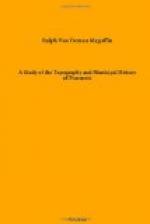THE GATES.
Strabo, in a well known passage,[57] speaks of Tibur and Praeneste as two of the most famous and best fortified of the towns of Latium, and tells why Praeneste is the more impregnable, but we have no mention of its gates in literature, except incidentally in Plutarch,[58] who says that when Marius was flying before Sulla’s forces and had reached Praeneste, he found the gates closed, and had to be drawn up the wall by a rope. The most ancient reference we have to a definite gate is to the Porta Triumphalis, in the inscription just mentioned, and this is the only gate of Praeneste mentioned by name in classic times.
In 1353 A.D. we have two gates mentioned. The Roman tribune Cola di Rienzo (Niccola di Lorenzo) brought his forces out to attack Stefaniello Colonna in Praeneste. It was not until Rienzo moved his camp across from the west to the east side of the plain below the town that he saw how the citizens were obtaining supplies. The two gates S. Cesareo and S. Francesco[59] were both being utilized to bring in supplies from the mountains back of the city, and the stock was driven to and from pasture through these gates. These gates were both ancient, as will be shown below. Again in 1448 when Stefano Colonna rebuilt some walls after the awful destruction of the city by Cardinal Vitelleschi, he opened three gates, S. Cesareo, del Murozzo, and del Truglio.[60] In 1642[61] two more gates were opened by Prince Taddeo Barberini, the Porta del Sole, and the Porta delle Monache, the former at the southeast corner of the town, the latter in the east wall at the point where the new wall round the monastery della Madonna degl’Angeli struck the old city wall, just above the present street where it turns from the Via di Porta del Sole into the Corso Pierluigi. This Porta del Sole[62] was the principal gate of the town at this time, or perhaps the one most easily defended, for in 1656, during the plague in Rome, all the other gates were walled up, and this one alone left open.[63]
The present gates of the city are: one, at the southeast corner, the Porta del Sole; two, near the southwest corner, where the wall turns up toward S. Martino, a gate now closed;[64] three, Porta S. Martino, at the southwest corner of the town; on the west side of the city, none at all; four, Porta S. Francesco at the northwest corner of the city proper; five, a gate in the arx wall, now closed,[65] beside the mediaeval gate, which is just at the head of the depression shown in plate III, the lowest point in the wall of the citadel; on the east, Porta S. Cesareo, some distance above the town, six; seven, Porta dei Cappuccini, which is on the same terrace as Porta S. Francesco; eight, Portella, the eastern outlet of the Via della Portella; nine, a postern just below the Portella, and not now in use;[66] ten, Porta delle Monache or Santa Maria, in front of the church of that name. The most ancient of these, and the ones which were in the earliest circle of the cyclopean wall, are five in number: Porta S. Francesco,[67] the gate into the arx, Porta S. Cesareo,[68] Porta dei Cappuccini, and the postern at the corner where the early cyclopean cross wall struck the main wall.




